Posted on June 30, 2011 at 7:35 pm
Ken Waltzer Replies to My Question
By Carolyn Yeager
(Last edited on July 3 and added to on July 9)
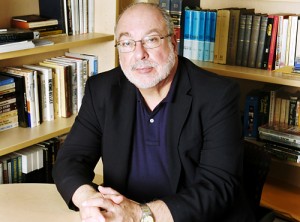 In my previous blog of June 14, I asked the question “What happened to Waltzer’s book about the ‘boys of Buchenwald?’” On June 27, Ken Waltzer (pictured right) answered me … sort of. He said he was not having any trouble with the book, but he didn’t say when we could expect to read it. Not a word on that. But he assured Elie Wiesel Cons the World readers that we will find it a powerful story when we do.
In my previous blog of June 14, I asked the question “What happened to Waltzer’s book about the ‘boys of Buchenwald?’” On June 27, Ken Waltzer (pictured right) answered me … sort of. He said he was not having any trouble with the book, but he didn’t say when we could expect to read it. Not a word on that. But he assured Elie Wiesel Cons the World readers that we will find it a powerful story when we do.
Being a person who likes to stick with the practical and real, I’m not satisfied with Prof. Waltzer’s answer because it avoids the real questions in favor of repeating his claims without supporting them. On top of that, he called me a bigot. This is a grievous fault, it seems to me, in a man who is a Professor of Jewish Studies and German History at Michigan State University. Let’s take a look at what he’s said.
Before writing a comment to my blog, Waltzer first wrote a comment on June 26 to Scrapbookpages Blog. The blogmaster there, who goes by the name of “furtherglory,” had blogged June 16 on my ‘boys of Buchenwald’ article. He checks out new articles about Holocaust on the Internet daily, and seems pretty interested in Elie Wiesel. He added an update to the original blog and asked the question: “Has Ken Waltzer finally figured out that there were three separate people involved in this controversy and all three are named Wiesel.” No, he hasn’t. Waltzer continues to insist that they are all Elie Wiesel.
This is what Ken Waltzer said on Scrapbookpages Blog:
All the ridiculous claims that Wiesel was not Wiesel, Wiesel was not at Buchenwald, Wiesel was a different Wiesel are false, There was one Lazar Wiesel at Buchenwald. He arrived with his father, who appears as Abram, born 1900, and who died shortly after arrival. (He signs his name Shlomo.) Wiesel was then moved to block 66, the children’s block, part of a large child-saving operation by people aligned with the German-Communist led international underground in the camp. He is there with others from Sighet who affirm he is there. He is there until liberation. He is interviewed by American military authorities there. He goes to France.,…
There is no question, indeed there is firm proof, Elie Wiesel was at Buchenwald. And the sections of Night written about Buchenwald are generally accurate and conform to the experience he had.
Comment by Ken Waltzer — June 26, 2011 @ 6:53 am
And this is what Furtherglory said in reply:
Thanks for your comment. A man named Lazar Wiesel was given the tattoo number A-7713 at Auschwitz. A man named Abram Viesel was given the number A-7712 at Auschwitz. Both of them were transferred to Buchenwald in January 1945. Lazar Wiesel, born at Maromarossiget on 4 September 1913, an apprentice locksmith, political detainee and Hungarian Jew, was registered at Buchenwald on 26 January 1945 and assigned the ID number 123565. This must be the man whom you have identified as Elie Wiesel and Abram Viesel is the man that you have identified as Elie’s father. In the records at Auschwitz, Abram Viesel was born on 10 October 1900 at Marmarosz. He was old enough to be Elie Wiesel’s father, but not old enough to be the father of Lazar Wiesel, who was born in 1913, according to the records.
Elie’s full name is Eliezer Wiesel and he was born in Sighet, Romania (Marmarossiget) which was a part of Hungary in 1944. Elie claims he was born on September 30, 1928. Are you saying that his birthdate was mistakenly written as Sept 4, 1913 at Buchenwald?
A man named Lázár Wiesel, (note difference in spelling) born 4 October 1928, was also registered at Buchenwald and given the ID Number 123165. Are you saying that this man did not exist?
You wrote that Elie Wiesel (Lazar Wiesel) was interviewed by the American military. Lázár Wiesel filled out a US Army questionaire on 22 April 1945 at Buchenwald; he stated on the questionaire that he was born at Màromarossziget on 4 October 1928; he was a student who was arrested on 16 April 1944 and interned at Auschwitz and Monowitz. Are you saying that this man didn’t exist?
The records at the Buchenwald Gedenkstätte show that Lázár Wiesel was sent to Paris on 16 July 1945 with a convoy of surviving children and is registered on the transport list. The name Lazar Wiesel is not on the transport list to Paris, which makes sense since he was born in 1913.
Lazar Wiesel’s name was on the transport list from Auschwitz to Buchenwald, but the name Lázár Wiesel was not. That doesn’t mean that Lázár was never at Auschwitz. He could have been sent, from Auschwitz, to some other camp, such as Gross Rosen, and then sent to Buchenwald when Gross Rosen, or whatever other camp, was evacuated.
Comment by furtherglory — June 26, 2011 @ 3:40 pm
It didn’t take furtherglory long to answer Prof. Waltzer and I thought he did a fantastic job. I mean, he’s got it all right and in order and that’s why I’m copying it here … so I won’t have to do it myself. Furtherglory asked Prof. Waltzer some questions, but Waltzer has not yet answered them. I have a feeling he won’t, either, because he doesn’t like to answer questions that he hasn’t posed himself, or are not easy ones. You see, Waltzer spends most of his time talking to his brainwashed students or to Jewish people at Jewish group events, like at the U.S. Holocaust Memorial Museum. Did you know that Jews run that museum and make up most of the attendees at its events? See here. They never ask tough questions.
But still, I was very happy to find a comment on my blog from Prof. Waltzer and I thank him for it. I think it says a lot for him that he is willing to engage, even if only to this extent. He wrote:
by Ken Waltzer On June 27, 2011 at 2:26 pm
Carolyn Yeager suspects that Ken Waltzer is having trouble with his Buchenwald book, esp. proving Elie Wiesel was at Buchenwald as he says he was. Nothing could be further from the truth.
The Buchenwald book is drawn on survivors’ experiences interviewed around the world and on documents from the Red Cross ITS and it will tell a powerful story of endurance and rescue inside Buchenwald.
And related to that larger story, in which Elie Wiesel is merely one of many boys who were helped and saved inside Buchenwald, there simply is no mystery whatsoever of Elie Wiesel, as Yeager claims. He arrived from Buna on a terrible transport on Jan. 26, 1945, with many others (including Miklos Gruner); he was accompanied by his father, who was recorded as Abram (but who signed his name as Shlomo); they were initially together in a barrack in the little camp, 59, I think, and then — after his father died — Elie Wiesel was moved in early February to block 66, the kinderblock. Miklos Gruner too was in block 66. Elie Wiesel was there with other boys from Sighet, who knew him; he was interviewed by military authorities after liberation, in order to permit departure from the camp; and he went after liberation in early June, 1945, to France, to Ecouis…. one among 425 boys who did so. He appears in subsequent pictures at Ambloy and Taverny where the religious boys were taken after Ecouis….
More important, Elie Wiesel’s commentary in Night bears fairly close resemblance to the actual experiences he had at Buchenwald — as recorded in camp documents.
He is the truth teller — Carolyn Yeager; you are the dealer in false claims and bigoted charges.
I am a bigot for doubting Elie Wiesel. I guess it’s some form of antisemitism to doubt that every word Elie Wiesel says is absolutely true … because he is the truth teller, according to Waltzer. And he, Waltzer, is going to prove it.
I consider what Prof. Waltzer is doing similar to ‘sleight of hand.’ He‘s repeating what he’s been saying all along … with a few convenient omissions (for example, the paper proving it he promised 6 months ago). We are to believe that 1) Eliezer Wiesel was listed as Lazar when he arrived, and then as Lázár Wiesel after liberation, with the wrong birth date both times; 2) his father Shlomo was recorded as Abram, also with the wrong birth date; 3) Shlomo is short for Abram or Abraham, not Solomon; and 4) those crazy, mixed-up Nazis got their records wrong.
Has Waltzer managed to falsify some document to show that the elder Wiesel was also known at times as Abraham? We’ll see. Then there is the problem with the pictures. He hasn’t told us which of these boys arriving at Ecouis in France in 1945 is Elie Wiesel. The USHMM tells us Elie is in this picture but doesn’t say where. Can you find him?
He also didn’t point out to us which of these ‘religious boys’ is Elie Wiesel. He titled it “In France — religious boys, including Elie Wiesel.” But how can we be sure?
What he seems to be doing is moving the attention away from these pictures to others of Elie Wiesel at Ambloy and Taverny. If there are such pictures I have never seen them. Have they been newly created? Why keep them hidden all these many years? (post note: See Comments #1,2 and 3) Does this mean that Waltzer is now declining to say that Wiesel appears in the famous Buchenwald photo (below)?
Or in this photo of the boys marching out of Buchenwald after liberation—which he has claimed for several years?
Prof. Waltzer, I know you consider yourself one of the privileged of the world, along with Elie Wiesel, but you must realize that even people of such privilege as yourselves cannot just change Shlomo to Abram as it suits you. When all others who were ‘liberated’ from the German camps are identified by matching their names, birth dates, and prisoner numbers, you cannot decide that in certain cases this formula does not apply and it is YOU who decides who is who.
From your comments, I’m expecting that when your book does finally come out, it will say that Shlomo is Abram and birth dates don’t matter, and this will be a small portion of the book overshadowed by other “powerful” stories of Jewish children. There may be no pictures of Elie Wiesel in France because he is just one of many in your powerful story. It will receive praise, coordinated in advance, from the Jewish media and academic class and no concern whatsoever will be expressed about any contradiction with the facts as they are contained in the Buchenwald archival documents.
But there will be one entity that will not let you alone or off the hook, and that is Elie Wiesel Cons The World website, and maybe some of our readers and followers. So I say—thanks for the comment but we are still waiting and watching for clarification from you.
UPDATE (July 1st):
Shlomo Wiesel was never at Auschwitz or Buchenwald. If he had been at Auschwitz there would be a record for a man named Solomon Viezel or Wiesel born in 1894, who was 50 years old in 1944.
>>We read in Frank N. Magill, ed., “Great Events from History II: Arts And Culture Series: Volume 4, 1955-1969“, Salem Press, Inc., Pasadena, CA., 1993, p. 1700:
“SHLOMO WIESEL (1894-1945), the father of Elie Wiesel“
>>And in in Michaël de Saint Cheron, “Elie Wiesel : L’homme de la mémoire“, Paris, Bayard (coll. Biographie), 1998, p. 25:
“Quant à son père, Shlomo, il ne fut vraiment proche de lui que dans les camps, ces lieux hors du temps, hors de l’espace des vivants, où ils partagèrent le même sort, le même enfer, ou presque.
Son père, né en 1894, à Màrmarossziget, était un juif tolérant et éclairé, alors que sa mère, née en 1898 à Bocsko, cadette de six enfants devenue orpheline de bonne heure, très pieuse, (Translation: His father Shlomo, born in 1894, in Marmarossziget, and his mother, born in 1898 in Bocsko.)
>>More importantly, Elie Wiesel filled out a form for the Yad Vashem Memorial in Israel sometime after the year 2000 (as my memory serves me) stating his father died as a holocaust victim.** On that form, he gave his father’s name as: Shlomo Vizel. He didn’t give a date of birth, but he gave a date of death as Jan. 27, 1945 and the cause of death as: Disease. He signed himself as Eli Vizel, son. That form can be viewed at the Yad Vashem archives online; that’s where I saw it.
Nowhere has Shlomo Vizel (Wiesel) ever been called Abram or Abraham, except now by Ken Waltzer in order to fit with the records for Lazar and Abram Wiesel at Buchenwald.
Stealing real victims and survivors identity is one of the lowest forms of behavior, according to holocaust survivor groups … or so they say. What do you think?
** It should be noted that Elie Wiesel did not fill out Yad Vashem forms for his mother or youngest sister affirming them as victims of the Holocaust. Why not? The logical reason is that he does not have any knowledge that they were indeed taken immediately to a “gas chamber” and killed, as the story has been put out for public comsumption. Even on Wiesel’s main page at Wikipedia it says they were “presumably killed.” That is all. Neither did his two older sisters, who were supposedly at Auschwitz for several months before being transferred to a sub-camp of Dachau, fill out this form for their mother and sister even though they are said to have been all together in the women’s line. These two surviving sisters were totally silent about their WWII experience, in spite of their famous brother, until Hilda, the eldest, gave a videotaped testimony to Steven Spielberg’s Shoah Foundation in the 1990’s.
Categories Featured | Tags: Abram Viesel, Boys from Buchenwald, Carolyn Yeager, Elie Wiesel, Ken Waltzer, Lazar Wiesel, Scrapbookpages Blog, Shlomo Viezel
Leave a Reply
By submitting a comment here you grant Elie Wiesel Cons the World a perpetual license to reproduce your words and name/web site in attribution. Inappropriate or irrelevant comments will be removed at an admin's discretion.

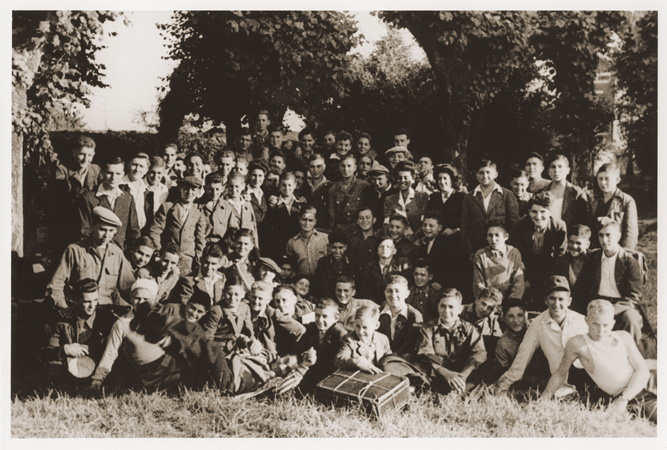
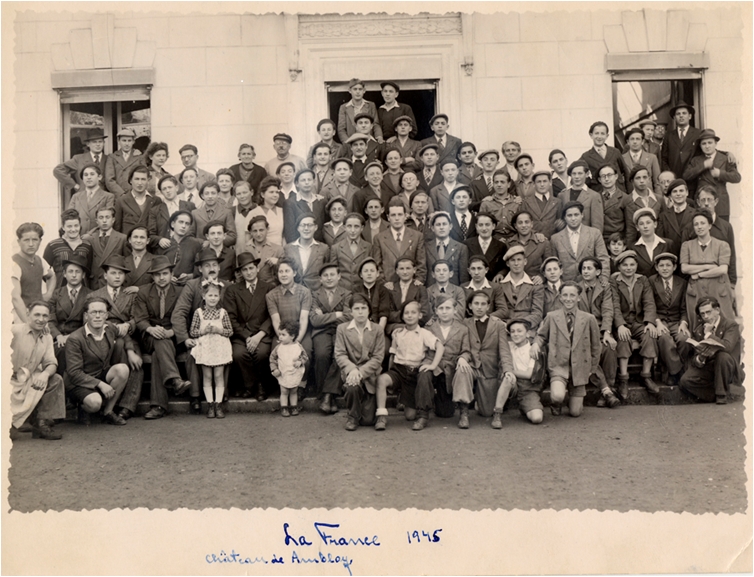
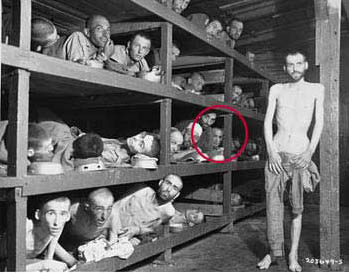
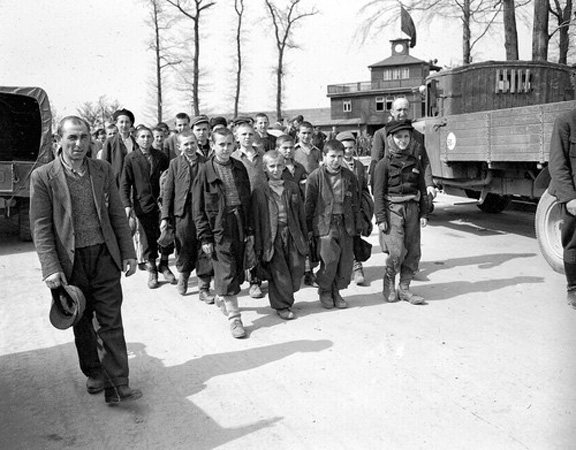

12 Comments to Ken Waltzer Replies to My Question
by Brian Josepher
On July 1, 2011 at 6:40 am
FYI. See the photo entitled “La France 1945 Chateau de Ambloy.” To the viewer’s left. Third row up from the bottom. The first row includes two men squatting and a girl in a white dress. The second row includes males in fedoras. In the third row, fourth boy over. He’s wearing a beret. His hands are visible. The hand of the boy behind him rests on his right shoulder. That’s Elie Wiesel, age 16, months after liberation from Buchenwald, some six months removed from the death march from Auschwitz to Buchenwald. As Professor Waltzer writes, there is incontrovertible proof of Wiesel’s Holocaust journey. Whether you choose to see it is a totally separate issue. Is it really a surprise that you choose blindness?
by Carolyn
On July 1, 2011 at 11:05 am
Brian,
Thanks for clarifying that Ambloy means the picture I posted in this article and am familiar with. It’s the one called the religious boys, the second group photograph shown in my article. I have located the figure you say is Elie Wiesel, but where is the proof? This boy is not exactly a dead ringer. Where is the list from that time, 1945, that gives the name of each boy, row by row? I’m sure it does not exist. Also, this boy does have a nose shaped like Elie Wiesel’s, but is quite different from the nose on the man in the famous Buchenwald photo taken only a few months earlier (see close up at The Many Faces of Elie Wiesel. The man in that photo has an aquiline nose and very high cheekbones. Do you insist that he is also Elie Wiesel?
Another consideration is that it is not “incontrovertible proof” that Elie Wiesel was at Buchenwald even if it can be proven that he is in the picture of religious boys at Ambloy. The only photo at the USHMM website showing boys at Ambloy is the first photo I’ve shown. Where is Elie Wiesel in that one? To know that Elie Wiesel was not already in France in Spring 1945, we should see him in the first picture of the arriving Buchenwald boys. I ask you or Ken Waltzer to point him out there.
On the USHMM page where you can purchase this (1st) photo, there is a long explanation of the placement of the boys after they reached their first destination in France–the Oeuvre de Secours aux Enfants (OSE), in the village of Ecouis, near Paris. It tells us that this particular home was closed in August because these boys were older and angrier than what it was prepared for. At that time, around 100 of the religiously observant boys who wanted kosher food were transferred to the Chateau d’Ambloy (Loir-et-Cher. That must be when this (2nd) picture was taken.
In October, they, along with the staff, were relocated to the Chateau de Vaucelles in Taverny (Val d’Oise). Ken Waltzer says he has a photograph from there too.
I conclude that we have still not seen “incontrovertible proof of Wiesel’s Holocaust journey,” as you put it. It is not I that am blind, but those who insist on reading into and seeing what is not actually there to be seen. Maybe Wiesel was at Taverny in Oct. ’45 (maybe), but was he at Buchenwald in Jan.-April ’45? Any more assistence you can give will be appreciated.
by Carolyn
On July 1, 2011 at 11:12 am
Brian, I would also remark that the boy you point out looks too tall to be Elie Wiesel, who only grew to be 5’9″ and also look rather over-confident. These are just remarks, not to be taken for more than that. I am looking forward to comments by others.
by Ray Goodwin
On July 1, 2011 at 11:25 pm
Hmmmm… – looks like another case of the “shoah business” boys being caught with their hands in the cookie jar — when they insinuate or start using their worn-out epithet “anti-Semitic” or such terms as “bigot.” If they had definitive proof about any of the weasel’s claims, they would have used it decades ago to silence critics. Since they have no real proof, they resort to name-calling. It is the last refuge.
RG
Texas
by J M Damon
On July 2, 2011 at 10:03 pm
Shame on you for challenging a semi divine survivor of “Holocaust” and his disciples.
You are engaged in the activity described by Prof. Egon Flaig a couple of years ago, posted at
:
…Revisionism is a vital part of the core substance of the Enlightenment.
When the scientific process of revising history is suppressed, scientists no longer have opportunity to evaluate arguments in accordance with objective criteria. Even worse, persons with intellectual interests – the heart and soul of the Renaissance and Enlightenment on account of their open and objective quest for truth and justice — lose their respected position in society. In the intolerant culture of “politically correct stupidity” as Rainer Paris calls it, the intellectual simply ceases to exist. And why is this?
— It is because in moralistic debates we no longer have to justify our arguments. Argumentation itself has been debased: moralizing makes all arguments equally good and equally bad. Even worse: moralizing creates a new hierarchy that is radically anti-intellectual. The GUTMENSCHEN are at the top of this hierarchy, and the winner of the debate is the person who screams most loudly about his moralistic superiority…
by Carolyn
On July 3, 2011 at 8:43 am
JM — I think you meant to add a link after :.
In any case, I looked for the article you refer to and found it here: http://www.codoh.com/newsite/sr/online/sr_155.pdf. Pages 10-12.
by Brian Josepher
On July 4, 2011 at 6:43 pm
The documents, generated by the Buchenwald authority in the winter of 1945 and later by the American military, offer corroborative proof of Wiesel’s self-stated history. Your document section contains a fraction of those documents. If you’re so fixated on Wiesel’s story, why don’t you take on an investigation? You will find survivors from his hometown who knew Wiesel as a boy. You will find survivors who entered Auschwitz-Birkenau around the same time as Wiesel and spent nine months with him in Buna. You will find bunkmates of his in Buchenwald. You will find Buchenwald survivors who then paralleled his OSE period. Many of his close friends from that time are still alive. His counselors at those orphanages are still alive. The evidence is all there, both in documentary and anecdotal form. You’re choosing a fallacy.
Take one moment and step outside your agenda. In your condemnation of Wiesel, you’re putting your trust in one source. What do you know about Miklos Grüner? Have you spoken to him? Do you know how he put together his anti-Wiesel drive? Do you know how he came across the documentation? Do you understand that he suppressed documentation?
Ask yourself some questions. Grüner, according to his self-stated history, lost his mother and a brother to the gas chambers of Birkenau in late May 1944. His father died in those same chambers on Yom Kippur 1944. And now, here he is, the poster boy of Holocaust deniers for his anti-Wiesel drive. Why would a survivor who lost his family in the gas chambers align himself with a community that denies those same killing machines? What does it say about the man? What does it say about his agenda? What does it say about his credibility?
These are some of the questions you should have been asking yourself. Had you, had you reviewed the full documentation, had you taken on a vigorous investigation, this website would not exist.
by Carolyn
On July 5, 2011 at 1:53 pm
Brian,
The answers to your questions are all very simple. Why don’t I take on an investigation? Because Auschwitz and Buchenwald will not send me documents from their archives. I don’t have the correct standing as an approved holocaust scholar. The same with Bad Arolson. I certainly have the right to ask you: Why has none of these documents you speak of been made public? If they are public, you should tell me where to find them. In addition, why has Prof. Waltzer not made them available? He stated publicly 6 months ago that he was coming out soon with a paper proving Elie Wiesel to have been at Buchenwald. No such paper has appeared.
What you are talking about anyway is witness testimony of friends and/or fellow Jews who have an interest in corroborating Wiesel’s story. This is a far cry from documentary proof which does exist for Miklos Gruner. My trust is not in the person of Miklos Gruner, but in the documents which he, as a survivor himself, was able to obtain from Buchenwald, and which he published for all the world to see. Neither you or Waltzer has done the same.
It’s rather shameful of you to question Gruner’s “agenda.” It seems obvious to me that his “agenda” is to expose a fraud who took the identity of a friend of his and fellow inmate at both Auschwitz III and Buchenwald. This shocked him, which tells me that he is a decent man and a loyal man. His sense of loyalty extends to his racial/religious group, the Jewish world community, and leads him to want to blame the Germans for more than they actually did to him and others. I find that understandable at least. Gruner’s father died, but not in a gas chamber.
You ask: Have I spoken to Gruner? Yes, I have and found him to be approachable and willing to talk in a candid manner. Naturally, knowing my disbelief in the official holocaust story makes him not able to support me or this website. You say he has suppressed documentation. Why don’t you bring forth that which he has suppressed? In other words, Brian, put your money where your mouth is. I have provided evidence for every claim I make. You and Waltzer have provided none.
by Rafael Soler
On July 6, 2011 at 12:21 pm
I am an American born of northern European stock, ergo: neither Jew nor Arab. I salute the efforts of Carolyn Yeager to bring intelligent investigation into the fantasy stories proffered by some Jews regarding Germany of World War II. As a young man I donned the uniform and believed the propaganda fed me until 1982.
The monster- Ariel Sharon opened my eyes. Since then I hunger for truthful revision of that period of human history.
Miss Yeager offers lucid transparency, apparently willing to change her views
according to evidentiary proofs, whereas the Jews do not. (Nor historically have they ever) From this point of reading the allegations of Ken Waltzer, making him a sad extension of the Jewish mythology, my hold is: Miss Carolyn Yeager has trumped with her clear analysis of facts. A fact is a fact,as a fiction is a lie. As one great leader pointed out- Jews cannot fool all the people –all of the time,
the holocaust industry is collapsing.
Carolyn Yeager -a True American –has done her part.
by Carolyn
On July 7, 2011 at 10:56 am
Thank you, Rafael. Your comment is very much appreciated.
by Daniel McGowan
On August 5, 2011 at 5:41 am
Excellent reporting on this “terrible fraud” who has reached god-like status in popular American culture.
by Carolyn
On August 6, 2011 at 6:27 am
Thank you, Mr. McGowan. I appreciate the complimentary comment.